

Women Motorcycle Events. Women In The Wind® - OFFICIAL WEBSITE. Motor Maids, Inc. > Home. Oppression by Omission: Women Soldiers Who Dressed and Fought as Men in the Civil War. By Maria Popova.
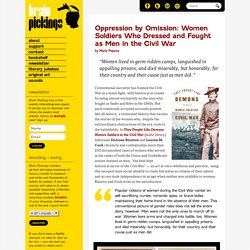
Young and Brave: Girls Changing History. Belle Boyd’s Civil War spying was so notorious that she was a celebrity at age 18.
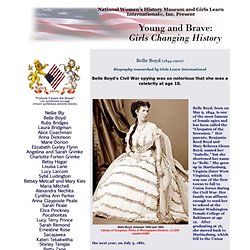
Belle Boyd, born on May 9, 1844, is one of the most famous of female spies and has been called the “Cleopatra of the Secession.” Her parents, Benjamin Reed Boyd and Mary Rebecca Glenn Boyd, named her “Isabelle,” but she shortened her name to “Belle.” She grew up in Martinsburg, Virginia (later West Virginia), which was one of the first towns to fall to Union forces during the Civil War. Her family was affluent enough to send her to school at the Mount Washington Female College of Baltimore at age 12. After graduating at 16, she moved back to Martinsburg, which fell to the Union the next year, on July 3, 1861.
Her career in espionage began shortly thereafter: when a Union soldier invaded their home and assaulted her mother, Belle fatally shot him. On July 29, 1862, Secretary of War Edwin Stanton personally issued a warrant for her arrest. Women and Fashions of the Early 20th Century - World War I Era - Clothing of 1914 - 1920. During the war, as men went off to fight, women took on jobs formerly filled by men.
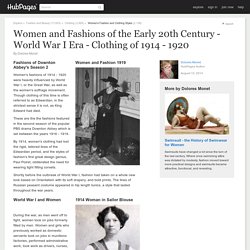
Women and girls who previously worked as domestic servants took on jobs in munitions factories, performed administrative work, took work as drivers, nurses, and farm workers. They volunteered for organizations like the Red Cross, and joined the military. Many of the occupations demanded the wearing of uniforms, including trousers. A military look crept into fashion designs as well with military style tunic jackets, belts, and epaulets. A new image of freedom and self respect led women away from traditional gender roles. The Jazz Age and Women/The 20's. 10 Amazing Women Who Led Rebellions. History Male revolutionaries such as Che Guevara have gone down as heroes for leading rebellions against “the Man.” But forgotten by history are the women who took on far greater powers than Fulgencio Batista.
Women and Fashions of the Early 20th Century - World War I Era - Clothing of 1914 - 1920. WWII Women & the Homefront. Updated February 27, 2008 THE HOMEFRONT American Cultural History - Decade 1940-1949 REVISIT THE HOMEFRONT - Find out what was going on in your area during the war - Just type in your zipcode and find out WWII happenings in your area!!!
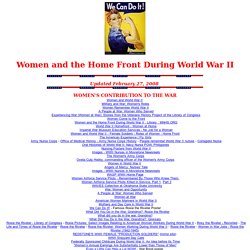
Also, find a list of local veteran stories!!! SUPER!!! Herstory. Herstory or hertory is history written from a feminist perspective, emphasizing the role of women, or told from a woman's point of view.
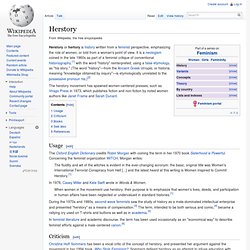
It is a neologism coined in the late 1960s as part of a feminist critique of conventional historiography,[1] with the word "history" reinterpreted, using a false etymology, as "his story. " (The word "history"—from the Ancient Greek ἱστορία, or historia, meaning "knowledge obtained by inquiry"—is etymologically unrelated to the possessive pronoun his.)[2] The herstory movement has spawned women-centered presses, such as Virago Press in 1973, which publishes fiction and non-fiction by noted women authors like Janet Frame and Sarah Dunant. Usage[edit] The Oxford English Dictionary credits Robin Morgan with coining the term in her 1970 book Sisterhood is Powerful. In 1976, Casey Miller and Kate Swift wrote in Words & Women, Criticism[edit] Books[edit] Recent books published on the topic include: See also[edit] References[edit]
History to Herstory. Women and Fashions of the Early 20th Century - World War I Era - Clothing of 1914 - 1920. Flapper. A flapper onboard ship (1929) Flappers were a "new breed" of young Western women in the 1920s who wore short skirts, bobbed their hair, listened to jazz, and flaunted their disdain for what was then considered acceptable behavior.
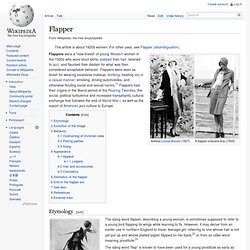
Flappers were seen as brash for wearing excessive makeup, drinking, treating sex in a casual manner, smoking, driving automobiles, and otherwise flouting social and sexual norms.[1] Flappers had their origins in the liberal period of the Roaring Twenties, the social, political turbulence and increased transatlantic cultural exchange that followed the end of World War I, as well as the export of American jazz culture to Europe. Etymology[edit] The slang word flapper, describing a young woman, is sometimes supposed to refer to a young bird flapping its wings while learning to fly.
Daring Dames. WWII Women & the Homefront. The Betty H. Carter Women Veterans Historical Project - University Archives - University Libraries. The Women Veterans Historical Papers is organized into two areas.

The first area consists of individual collections created by female veterans, such as the Susie Winston Bain Papers, #WV-0185. The second area consists of materials collected by University Archives that have been organized into general collections of textiles and artifacts and printed material. General Collections U.S. Air Force (including WASP, WAF) U.S. U.S. U.S. U.S. Nurses (including all Branches) American Red Cross British Military Service Civilians in Service.